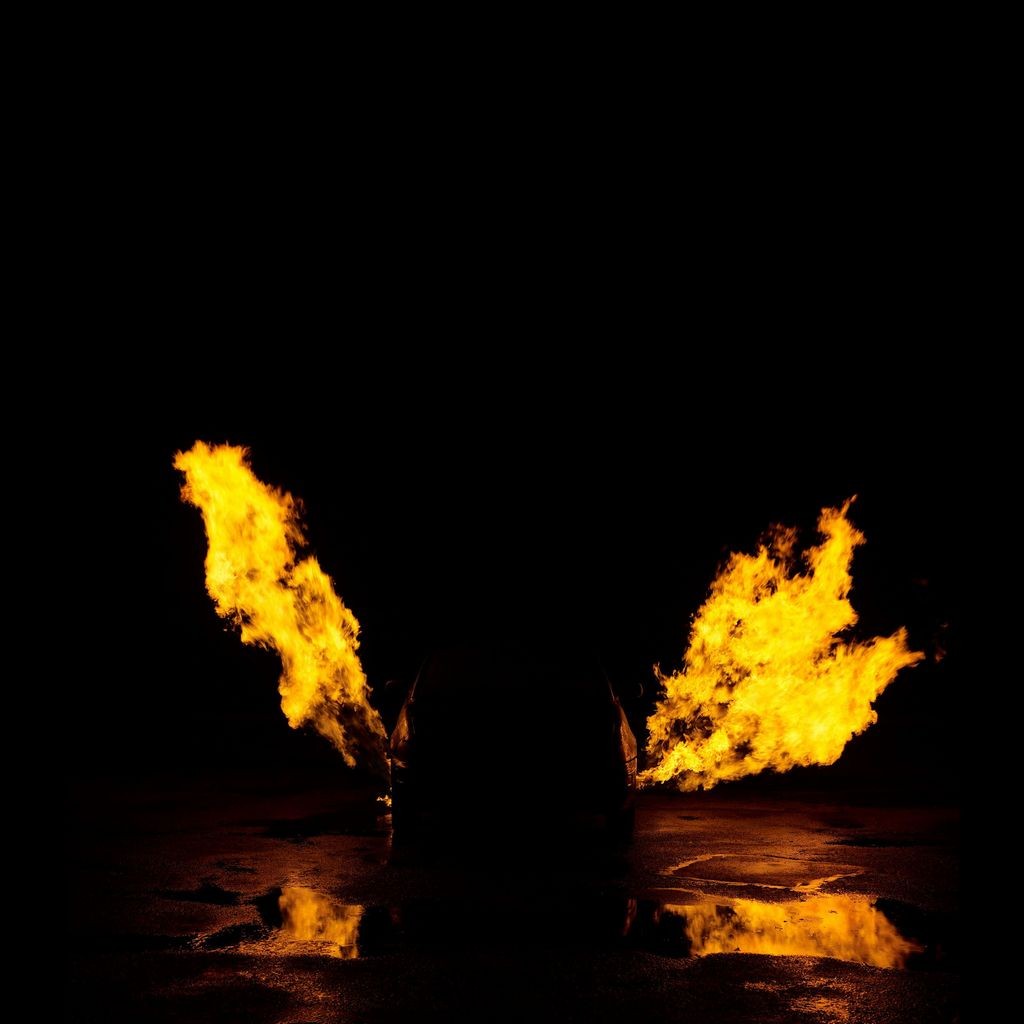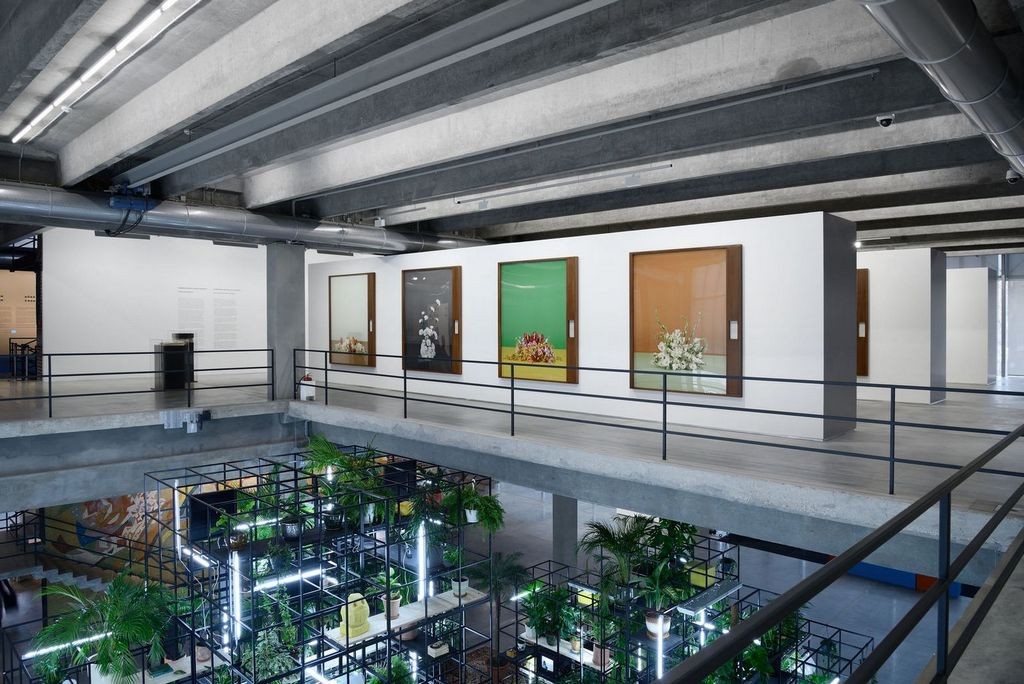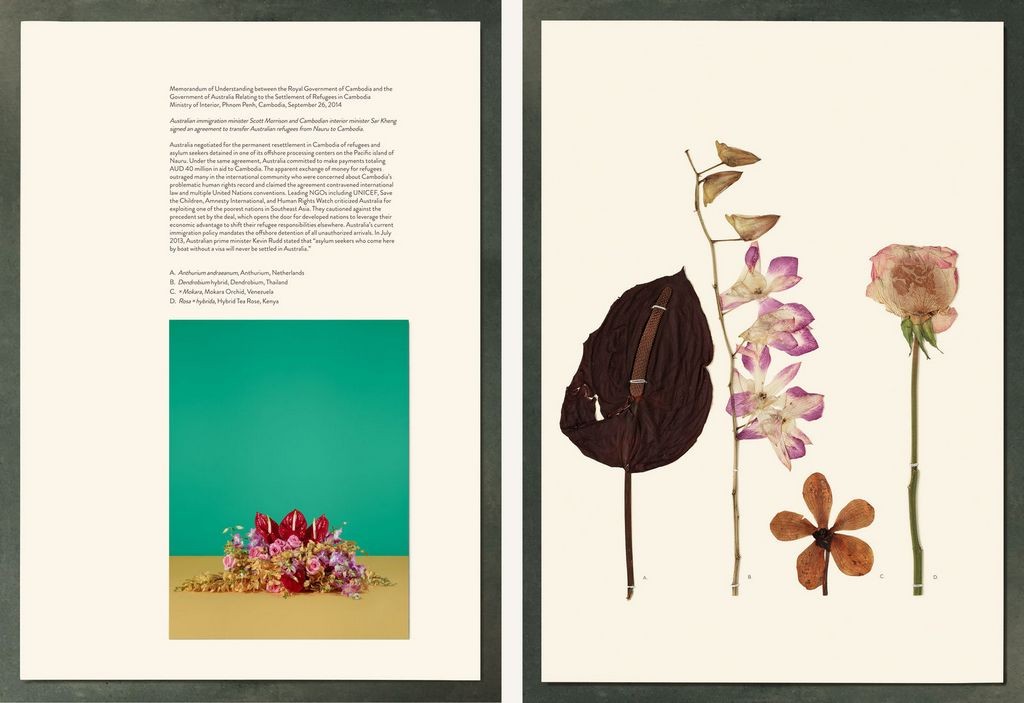Taryn Simon
Action Research / The Stagecraft of Power
17 Mar - 22 May 2016

Black Square IV, The Blaster, South Africa, Invented by Charl Fourie as an Anti-Hijacking system photographed installed on a Toyota Corolla, one of the most frequently carjacked vehicles in South Africa, 2009
Archival inkjet print
31 1/2 x 31 1/2 inches
© Taryn Simon. Courtesy Gagosian Gallery
Archival inkjet print
31 1/2 x 31 1/2 inches
© Taryn Simon. Courtesy Gagosian Gallery

"Agreement Establishing the International Islamic Trade Finance Corporation, Al-Bayan Palace, Kuwait City, Kuwait, May 30, 2006, Paperwork, and the Will of Capital, 2015"
Archival inkjet print and text on archival herbarium paper in mahogany fram
85 x 73 1/4 x 2 3/4 inches
© Taryn Simon. Courtesy Gagosian Gallery
Archival inkjet print and text on archival herbarium paper in mahogany fram
85 x 73 1/4 x 2 3/4 inches
© Taryn Simon. Courtesy Gagosian Gallery

Taryn Simon
Action Research / The Stagecraft of Power, Garage Museum of Contemporary Art, 2016
© Garage Museum of Contemporary Art
Action Research / The Stagecraft of Power, Garage Museum of Contemporary Art, 2016
© Garage Museum of Contemporary Art

Taryn Simon
Action Research / The Stagecraft of Power, Garage Museum of Contemporary Art, 2016
© Garage Museum of Contemporary Art
Action Research / The Stagecraft of Power, Garage Museum of Contemporary Art, 2016
© Garage Museum of Contemporary Art

Taryn Simon
Action Research / The Stagecraft of Power, Garage Museum of Contemporary Art, 2016
© Garage Museum of Contemporary Art
Action Research / The Stagecraft of Power, Garage Museum of Contemporary Art, 2016
© Garage Museum of Contemporary Art

Bird’s-eye view, Memorandum of Understanding between the Royal Government of Cambodia and the Government of Australia Relating to the Settlement of Refugees in Cambodia. Ministry of Interior, Phnom Penh, Cambodia, September 26, 2014, Gladiolus Grandiflorus Group, Gladiolus, Portugal, Asparagus setaceus, Plumosa Asparagus Fern, USA, Dianthus caryophyllus, Carnation, Colombia, Narcissus pseudonarcissus, Daffodil, Netherlands, Paperwork, and the Will of Capital, 2015
Pigmented concrete press, dried plant specimens, archival inkjet prints, text on herbarium paper, and steel brace
43 x 28 1/2 x 20 1/2 inches
© Taryn Simon. Courtesy Gagosian Gallery
Pigmented concrete press, dried plant specimens, archival inkjet prints, text on herbarium paper, and steel brace
43 x 28 1/2 x 20 1/2 inches
© Taryn Simon. Courtesy Gagosian Gallery
TARYN SIMON
Action Research / The Stagecraft of Power
17 March – 22 May 2016
Garage Museum of Contemporary Art presents Action Research / The Stagecraft of Power, featuring two new series by Taryn Simon. Continuing a collaboration that began three years ago between the acclaimed American artist and the Museum in Moscow, for the first time in her career Simon will also be working “live” to develop a new piece over the duration of the exhibition, providing audiences with unprecedented access to her singular research processes.
In the words of writer Salman Rushdie, Simon’s practice extends “the limits of what we are allowed to see and know,” to investigate and describe structures that influence life in postindustrial societies. She is first and foremost a storyteller of facts, using photography, film, sculpture, and installation to chronicle truths that are hard to believe. Through her dexterous juxtapositions, realities emerge as fictions, or imaginative narrations, but in her elaboration of them it becomes clear that they would be hard to invent.
Paperwork, and the Will of Capital resurrects agreements, contracts, treaties, and decrees drafted to influence systems of governance and economics after the 1944 United Nations Monetary and Financial Conference, in Bretton Woods, New Hampshire, U.S.A. This conference addressed the globalization of economies after World War II and led to the establishment of the International Monetary Fund (IMF) and the World Bank. In uncovering archival photographs of the numerous subsequent agreements between leaders of the 44 countries that initially participated in the conference, the artist observed that these powerful men are consistently flanked by floral arrangements during official ceremonies, created to convey the importance of the signatories and the institutions they represent.
Using these archival images as her starting point, Simon worked with a botanist to identify the flowers that marked each signing and then shipped 4,000 plant specimens to her New York studio from the Aalsmeer Flower Auction in the Netherlands. There she recreated the original arrangements—which became the artist’s own version of Dutch 17th century flower paintings of so-called “impossible bouquets”—that were photographed before the specimens were preserved and mounted in concrete presses. By focusing on the flower arrangements—what the artist describes as “the stagecraft of power”—Simon’s new photographs and sculptures mark their role as silent observers of man’s determination to control the fates of nations, institutions, and the natural world. In a race against time, each record—the archival images, the agreements, the photographs, the specimens—get subsumed over time, age, or degradation, to become distorted, unreliable versions of themselves and the history they represent.
Complementing this body of work with equal iconic visuality, Black Square is an ongoing series Simon began in 2006 that has never been exhibited in its entirety before. Like the renowned artwork of Kazimir Malevich that has inspired the title of the series, Simon’s photographs are loaded with tension and ambiguity. Influenced by her research and the lists of ideas she makes for other projects, each iteration depicts a subject that has a certain solitude or inherent contradiction. For example, Black Square IV pictures “The Blaster,” an anti-carjacking system installed beneath vehicles in South Africa. Black Square V includes a shadowed image of Henry Kissinger. Black Square XII documents the protocols of the Learned Elders of Zion that purports to document the minutes of a meeting between Jewish leaders outlining their plan to control the world. Despite having been exposed as a false document, it continues to be reproduced in many languages and distributed throughout the world.
The most recent iteration of the series is Black Square XVII, which Simon produced as part of Garage Field Research program in 2015, the centenary year of the debut exhibition of Malevich’s Black Square painting. In her most ambitious research initiative to date, after two years of conversations by proxy with agencies, scientists, nuclear physicists, and nuclear laborers in various regions in Russia, the artist embarked on a collaboration with Russia’s State Atomic Energy Corporation (ROSATOM)—the first the company has ever undertaken—to prepare a work of art made from nuclear material. In 3015, approximately one thousand years after its creation, the resulting work—a black square made from vitrified nuclear waste containing a letter to the future written by Simon—will be permanently displayed at Garage in a custom-designed void that has been prepared in the new museum building.
Black Square XVII is currently being stored in a concrete reinforced steel container, within a holding chamber surrounded by clay-rich soil, at the Radon nuclear waste disposal plant in Sergiev Posad, located 72 km northeast of Moscow. It will reside at the facility until its radioactive properties have diminished to levels deemed safe for human exposure and exhibition. Central to the artist’s concept for this project is the agreement that Garage Museum of Contemporary Art will be the repository for the artwork when it is completed, raising questions of permanence, preservation, visibility, and ownership. In effect, this is Garage’s first permanent work of art, although for centuries to come the only evidence of its existence will be the site that awaits its installation, and the plaque that tells its story.
While Black Square XVII will take many years to finally manifest itself for audiences, the Field Research project gave rise to a film, which is under development. It is the surreal story of an American citizen constructing an object with a Russian nuclear agency, which can only be “seen” by the protagonist indirectly through film, photography, discussion, and correspondence. The documentary explores aspects of the atomic industry from radioactive waste storage and disposal to the implications of the atomic bomb and anthropogenic catastrophes. The first part of the documentary was shot at a ROSATOM factory during the vitrification and storage process for Black Square XVII. The second will be shot during Simon’s exhibition at Garage, live, in a customized film studio. There, experts from different fields will be invited to speak on eight related subjects, including Atomic Industry as an International Program; Between War and Peace; Futurology and the New Fear of the Future; and Art After the End of the World.
Says the artist: “Many parts of the film are shot by proxy, following my specific instructions, recording places where I’m not allowed to enter as a foreigner. Other scenes include experiences of the atomic industry to which I would otherwise have no access. By this and all the psychological sludge it confronts, the film’s authorship, ownership, and story are in many ways up for grabs—much like the object itself.”
Due for completion in September 2017, the production of the film will constitute the third aspect of the collaboration between the Museum and the artist.
Paperwork, and the Will of Capital is being presented at Gagosian Gallery in New York from February 18- March 26, 2016.
Taryn Simon was born in 1975 in New York, USA, where she lives and works. Recent exhibitions include: Taryn Simon: Rear Views, A Star-forming Nebula, and the Office of Foreign Propaganda, Jeu de Paume, Paris (2015); A Polite Fiction, Louis Vuitton Foundation, Paris (2014); There Are Some Who Are in Darkness, Museum Folkwang, Essen, Germany (2013); A Living Man Declared Dead and Other Chapters I–XVIII, Museum of Modern Art, New York (2012); A Living Man Declared Dead and Other Chapters, Tate Modern, London and Neue Nationalgalerie, Berlin (2011).
Simon was a Guggenheim fellow in 2001. Her works have been acquired for the Metropolitan Museum of Art, Tate Modern, Whitney Museum of American Art, Centre Pompidou, and Museum of Contemporary Art in Los Angeles. She participated in the 54th (2011) and 56th (2015) Venice biennales.
Action Research / The Stagecraft of Power
17 March – 22 May 2016
Garage Museum of Contemporary Art presents Action Research / The Stagecraft of Power, featuring two new series by Taryn Simon. Continuing a collaboration that began three years ago between the acclaimed American artist and the Museum in Moscow, for the first time in her career Simon will also be working “live” to develop a new piece over the duration of the exhibition, providing audiences with unprecedented access to her singular research processes.
In the words of writer Salman Rushdie, Simon’s practice extends “the limits of what we are allowed to see and know,” to investigate and describe structures that influence life in postindustrial societies. She is first and foremost a storyteller of facts, using photography, film, sculpture, and installation to chronicle truths that are hard to believe. Through her dexterous juxtapositions, realities emerge as fictions, or imaginative narrations, but in her elaboration of them it becomes clear that they would be hard to invent.
Paperwork, and the Will of Capital resurrects agreements, contracts, treaties, and decrees drafted to influence systems of governance and economics after the 1944 United Nations Monetary and Financial Conference, in Bretton Woods, New Hampshire, U.S.A. This conference addressed the globalization of economies after World War II and led to the establishment of the International Monetary Fund (IMF) and the World Bank. In uncovering archival photographs of the numerous subsequent agreements between leaders of the 44 countries that initially participated in the conference, the artist observed that these powerful men are consistently flanked by floral arrangements during official ceremonies, created to convey the importance of the signatories and the institutions they represent.
Using these archival images as her starting point, Simon worked with a botanist to identify the flowers that marked each signing and then shipped 4,000 plant specimens to her New York studio from the Aalsmeer Flower Auction in the Netherlands. There she recreated the original arrangements—which became the artist’s own version of Dutch 17th century flower paintings of so-called “impossible bouquets”—that were photographed before the specimens were preserved and mounted in concrete presses. By focusing on the flower arrangements—what the artist describes as “the stagecraft of power”—Simon’s new photographs and sculptures mark their role as silent observers of man’s determination to control the fates of nations, institutions, and the natural world. In a race against time, each record—the archival images, the agreements, the photographs, the specimens—get subsumed over time, age, or degradation, to become distorted, unreliable versions of themselves and the history they represent.
Complementing this body of work with equal iconic visuality, Black Square is an ongoing series Simon began in 2006 that has never been exhibited in its entirety before. Like the renowned artwork of Kazimir Malevich that has inspired the title of the series, Simon’s photographs are loaded with tension and ambiguity. Influenced by her research and the lists of ideas she makes for other projects, each iteration depicts a subject that has a certain solitude or inherent contradiction. For example, Black Square IV pictures “The Blaster,” an anti-carjacking system installed beneath vehicles in South Africa. Black Square V includes a shadowed image of Henry Kissinger. Black Square XII documents the protocols of the Learned Elders of Zion that purports to document the minutes of a meeting between Jewish leaders outlining their plan to control the world. Despite having been exposed as a false document, it continues to be reproduced in many languages and distributed throughout the world.
The most recent iteration of the series is Black Square XVII, which Simon produced as part of Garage Field Research program in 2015, the centenary year of the debut exhibition of Malevich’s Black Square painting. In her most ambitious research initiative to date, after two years of conversations by proxy with agencies, scientists, nuclear physicists, and nuclear laborers in various regions in Russia, the artist embarked on a collaboration with Russia’s State Atomic Energy Corporation (ROSATOM)—the first the company has ever undertaken—to prepare a work of art made from nuclear material. In 3015, approximately one thousand years after its creation, the resulting work—a black square made from vitrified nuclear waste containing a letter to the future written by Simon—will be permanently displayed at Garage in a custom-designed void that has been prepared in the new museum building.
Black Square XVII is currently being stored in a concrete reinforced steel container, within a holding chamber surrounded by clay-rich soil, at the Radon nuclear waste disposal plant in Sergiev Posad, located 72 km northeast of Moscow. It will reside at the facility until its radioactive properties have diminished to levels deemed safe for human exposure and exhibition. Central to the artist’s concept for this project is the agreement that Garage Museum of Contemporary Art will be the repository for the artwork when it is completed, raising questions of permanence, preservation, visibility, and ownership. In effect, this is Garage’s first permanent work of art, although for centuries to come the only evidence of its existence will be the site that awaits its installation, and the plaque that tells its story.
While Black Square XVII will take many years to finally manifest itself for audiences, the Field Research project gave rise to a film, which is under development. It is the surreal story of an American citizen constructing an object with a Russian nuclear agency, which can only be “seen” by the protagonist indirectly through film, photography, discussion, and correspondence. The documentary explores aspects of the atomic industry from radioactive waste storage and disposal to the implications of the atomic bomb and anthropogenic catastrophes. The first part of the documentary was shot at a ROSATOM factory during the vitrification and storage process for Black Square XVII. The second will be shot during Simon’s exhibition at Garage, live, in a customized film studio. There, experts from different fields will be invited to speak on eight related subjects, including Atomic Industry as an International Program; Between War and Peace; Futurology and the New Fear of the Future; and Art After the End of the World.
Says the artist: “Many parts of the film are shot by proxy, following my specific instructions, recording places where I’m not allowed to enter as a foreigner. Other scenes include experiences of the atomic industry to which I would otherwise have no access. By this and all the psychological sludge it confronts, the film’s authorship, ownership, and story are in many ways up for grabs—much like the object itself.”
Due for completion in September 2017, the production of the film will constitute the third aspect of the collaboration between the Museum and the artist.
Paperwork, and the Will of Capital is being presented at Gagosian Gallery in New York from February 18- March 26, 2016.
Taryn Simon was born in 1975 in New York, USA, where she lives and works. Recent exhibitions include: Taryn Simon: Rear Views, A Star-forming Nebula, and the Office of Foreign Propaganda, Jeu de Paume, Paris (2015); A Polite Fiction, Louis Vuitton Foundation, Paris (2014); There Are Some Who Are in Darkness, Museum Folkwang, Essen, Germany (2013); A Living Man Declared Dead and Other Chapters I–XVIII, Museum of Modern Art, New York (2012); A Living Man Declared Dead and Other Chapters, Tate Modern, London and Neue Nationalgalerie, Berlin (2011).
Simon was a Guggenheim fellow in 2001. Her works have been acquired for the Metropolitan Museum of Art, Tate Modern, Whitney Museum of American Art, Centre Pompidou, and Museum of Contemporary Art in Los Angeles. She participated in the 54th (2011) and 56th (2015) Venice biennales.
